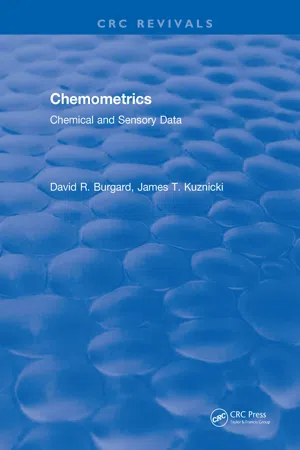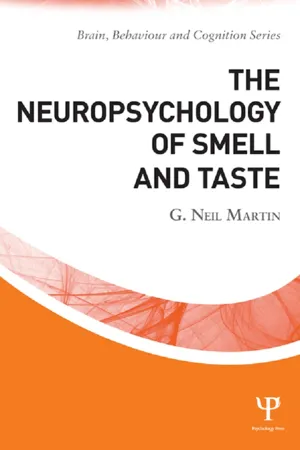Psychology
Chemical Senses
Chemical senses refer to the sensory systems responsible for detecting and processing chemical stimuli in the environment. This includes the senses of taste and smell, which play a crucial role in our perception of flavors and odors. These senses are closely linked to our emotions, memories, and overall sensory experiences.
Written by Perlego with AI-assistance
Related key terms
3 Key excerpts on "Chemical Senses"
- eBook - ePub
Chemometrics
Chemical and Sensory Data
- David R. Burgard(Author)
- 2018(Publication Date)
- CRC Press(Publisher)
Chapter 5 The Chemical SensesI. Introduction
This chapter reviews the functional anatomy and perceptual processes of the Chemical Senses: taste, smell, and the common chemical sense. While it is possible to collect sensory data without this knowledge, interpretation of that data is not. In sensory evaluation studies, the human subject is often viewed as an instrument which is used to determine some property of the product samples being studied. Since the product is of primary interest, it is often easy to overlook the properties of the instrument. It is those properties, however, which determine the type and quality of data that is obtained. As an analogy, consider a liquid chromatograph. This instrument can be used to determine the concentrations of specific chemicals in a sample, the relative amounts of several chemicals in the sample, or even the total number of different chemicals present. The type and quality of data obtained depends on several variables. These include the way the samples are prepared for injection into the instrument, the solvent used to extract the samples and in which they are dissolved, the material in the column, the pressure at which the samples are pumped through the column, etc. A change in any one or combination of these variables will affect the data obtained in measurable ways. In a similar fashion, the human instrument possesses properties, which are not determined by the investigator but are brought to the situation, that affect the data obtained in a sensory evaluation study. These properties, not all of which are clearly understood, are determined by functional operating characteristics of the sensory systems. The analogy between a human sensory instrument and a liquid chromatograph cannot be carried too far, however, because unlike the passive chromatograph the human instrument is an active instrument. The information fed into the human instrument is actively processed such that the output of the instrument does not always, or even usually, stand in one-to-one relationship with the input. This processing begins at the earliest stages of the perceptual process, interaction of sample with sensory receptors, and continues through the last stages of the process in which the subject makes some sort of judgment about the sample (e.g., quality, intensity, or hedonic tone of the sample). The sensory properties of the human instrument are also affected by higher-order properties called cognitive processes which affect the data and, perhaps of greatest importance, the ability of the subject to provide the data of interest. To properly interpret output from a sensory system, some knowledge of that system is absolutely necessary. Fortunately, the study of sensory processes is a very active area and several excellent texts and handbooks are available.1 , 2 , 3 , 4 , 5 , 6 , 7 and 8 - eBook - ePub
- G. Neil Martin(Author)
- 2013(Publication Date)
- Psychology Press(Publisher)
1 Smell and Taste An introduction to the psychology of chemosensation1.1 Unique features of smell and taste
Smell and taste are chemosenses, that is, they are sensory systems that respond to chemical stimulation and whose chemical stimuli bind to receptors to create a sensation. Both are two of the most neglected and unusual in the sensory panoply in that each exhibits features that uniquely and dramatically separate it from the dominant senses of vision and audition, and even somatosensation. For example:- Olfaction is the only sense with receptors directly exposed to the environment;
- Humans have an ability to detect hundreds, if not thousands, of different odours but only five or so tastes. However, the same humans are notoriously poor at identifying such odours;
- There is no agreed classification system for odour; there is more agreement for taste;
- Unlike vision, hearing and touch there is no olfactory dimension that relates stimuli to sensation; it has no predictable frequencies nor limited spectra (Mackay-Sim and Royet, 2006);
- Also unlike vision and audition, the olfactory system requires a third of the genome; vision requires three genes; audition requires a structure that develops from genes coding for other aspects of development (Mackay-Sim and Royet, 2006);
- The olfactory cortex has three layers, unlike most other sensory cortices;
- Taste and smell receptors regenerate every sixty days – thus, our current chemoreceptors did not exist two months ago;
- Smell is probably the most manipulable and confusable of the senses: people can be convinced that an odourless substance is odorous or that they are smelling something they are not;
- Taste is invariably confused with smell although smell provides the greatest contribution to food flavour;
- Olfactory dysfunction may be a better marker of risk of degenerative disease (e.g. Alzheimer’s Disease (AD)) than more conventional neurophysiological or clinical measures.
- eBook - ePub
Fundamentals of Children and Young People's Anatomy and Physiology
A Textbook for Nursing and Healthcare Students
- Ian Peate, Elizabeth Gormley-Fleming, Ian Peate, Elizabeth Gormley-Fleming(Authors)
- 2021(Publication Date)
- Wiley-Blackwell(Publisher)
Chapter 18 The senses Joanne OutteridgeSchool of Nursing and Midwifery, Anglia Ruskin University, Cambridgeshire, UKAim
The aim of this chapter is to discuss the special senses of smell, taste, hearing and sight, exploring how the structures involved receive environmental signals and process these into nerve impulses to be interpreted by the brain.Learning outcomes
By the end of this chapter, the reader will be able to:- State the anatomical, physiological and neurological requirements for the Chemical Senses of taste and smell.
- Outline how the anatomy of the ear enables it to perform the functions of both hearing and equilibrium (balance).
- Discuss how hearing and balance are sensed and translated into neurological signals to be processed by the brain.
- Recognise and label the anatomical structures of the eye.
- Explain how the retina processes visual images, and the role of the visual cortex of the brain in receiving and processing those images.
- Critically analyse how normal growth, development and family functioning are affected when a child or a young person has a hearing or visual disorder.
Test your prior knowledge
- To what do the terms ‘olfaction’ and ‘olfactory’ refer?
- Where are the taste buds situated?
- What are the five main tastes that we can process?
- What is the Eustachian tube, and where is it?
- What is the organ of Corti responsible for?
- What are the semicircular canals responsible for?
- What is the coloured part of the front of the eye called, and what is its function?
- What are the rods and cones of the retina?
- What is your ‘blind spot’?
- At what age do all children in the United Kingdom have routine visual screening, and why?
Introduction
The way in which children and young people interact with their environment relies on their senses receiving information, their brains processing that information and then providing either a physical or a culturally appropriate social response to that information. The aim of this chapter is to introduce the special senses of smell, taste, hearing, balance and sight, which along with the tactile general senses of pain, pressure and temperature (Chapter 19
Learn about this page
Index pages curate the most relevant extracts from our library of academic textbooks. They’ve been created using an in-house natural language model (NLM), each adding context and meaning to key research topics.


